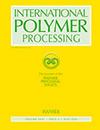机械化学法制备的马来酸酐和苯乙烯接枝聚丙烯对可生物降解的聚碳酸亚丙酯/聚丙烯纺粘非织造切片共混体系的反应增容
IF 1.1
4区 工程技术
Q4 ENGINEERING, CHEMICAL
引用次数: 0
摘要
摘要聚碳酸亚丙酯(PPC)/聚丙烯(PP)纺粘非织造布切片因其优异的生物降解性、柔韧性、生物相容性和CO2利用率等性能而备受关注。然而,由于PPC和PP之间的热力学不相容性较差,这种绿色材料的应用受到限制。本文采用机械化学方法制备了马来酸酐(MAH)和苯乙烯(St)接枝的PP(PP-g-(MAH-co-St)),接枝率GMAH=1.40 %, 作为相容剂,通过熔融共混制备了可生物降解的PPC/相容剂/PP复合纺粘非织造切片。系统研究了相容剂含量对PPC/PP-g-(MAH-co-St)/PP的拉伸强度、断裂伸长率、熔体流动速率、热性能和微观形态的影响。探讨了PP-g-(MAH-co-St)在PPC/PP纺粘非织造布复合切片中的增容机理。结果表明,该绿色PP-g-(MAH-co-St)具有明显的反应增容作用。因此,它可以被认为是可生物降解的PPC/PP纺粘非织造切片的良好相容剂。本文章由计算机程序翻译,如有差异,请以英文原文为准。
Reactive compatibilization of polypropylene grafted with maleic anhydride and styrene, prepared by a mechanochemical method, for a blend system of biodegradable poly(propylene carbonate)/polypropylene spunbond nonwoven slice
Abstract Poly(propylene carbonate) (PPC)/polypropylene (PP) spunbond nonwoven slice has gained more attention, owing to its excellent properties, such as biodegradability, flexibility, biocompatibility, and CO2 utilization. However, the applications of this green material are limited due to the poor thermodynamic incompatibility between PPC and PP. In this paper, PP grafted with maleic anhydride (MAH) and styrene (St) (PP-g-(MAH-co-St)), prepared by a mechanochemical method and having a grafting percentage GMAH = 1.40 %, was used as a compatibilizer to prepare a biodegradable PPC/compatibilizer/PP composite-spunbond nonwoven slice by melt-blending. The effects of compatibilizer content on the tensile strength, elongation at break, melt flow rate, thermal properties, and micro-morphology of PPC/PP-g-(MAH-co-St)/PP were systematically studied. Furthermore, the mechanism of compatibilization of PP-g-(MAH-co-St) in the PPC/PP spunbond nonwoven composite slice is discussed. The results indicated that this green PP-g-(MAH-co-St) exhibited a clear reactive compatibilization effect. Therefore, it can be considered as a good compatibilizer for the biodegradable PPC/PP spunbond nonwoven slice.
求助全文
通过发布文献求助,成功后即可免费获取论文全文。
去求助
来源期刊

International Polymer Processing
工程技术-高分子科学
CiteScore
2.20
自引率
7.70%
发文量
62
审稿时长
6 months
期刊介绍:
International Polymer Processing offers original research contributions, invited review papers and recent technological developments in processing thermoplastics, thermosets, elastomers and fibers as well as polymer reaction engineering. For more than 25 years International Polymer Processing, the journal of the Polymer Processing Society, provides strictly peer-reviewed, high-quality articles and rapid communications from the leading experts around the world.
 求助内容:
求助内容: 应助结果提醒方式:
应助结果提醒方式:


